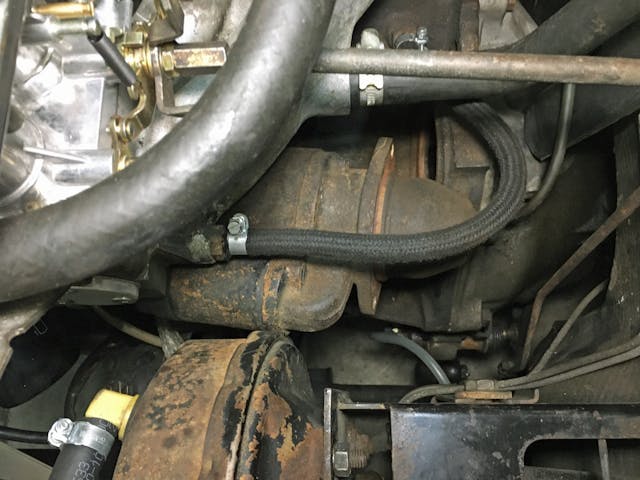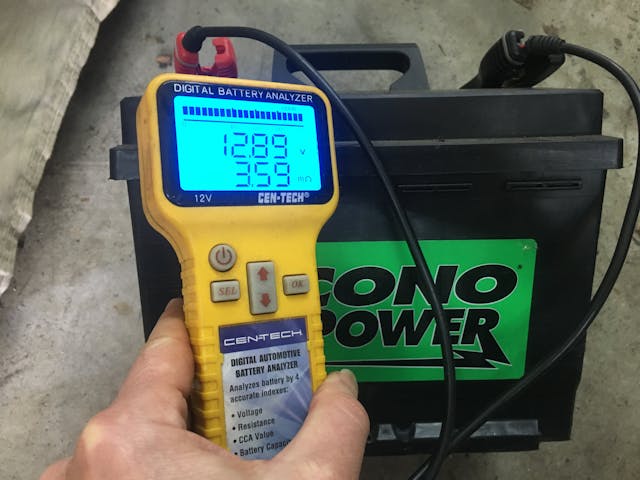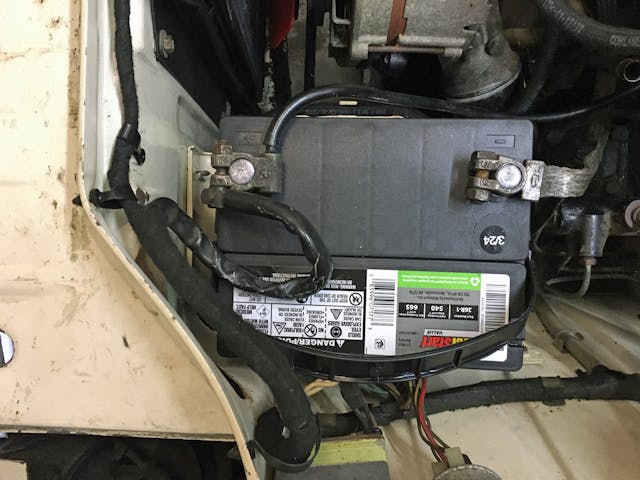Getting a No-Start Diagnosis Wrong
Back in February, I wrote about troubleshooting a no-start condition. It was, I thought, a useful piece that walked you down the decision tree that delineates car-won’t-crank, car-cranks-slowly, and car-cranks-quickly-but-won’t-start problems, and tells you how to test for each and which component is likely bad.
However, I didn’t delve deeply enough into the issue that a weak battery and a weak starter motor can mimic one another. How do I know? Because I just got bitten by it.
Here’s the deal. As I said in the no-start story, what cranks the engine is the battery, the starter, the cables connecting the two, and the ignition switch that feeds 12 volts to the starter solenoid. If you turn the key and hear weak cranking or nothing at all, the first thing to do is check the voltage at the battery with a voltmeter—that’s exactly what AAA will do if you make a service call. A fully-charged battery should read 12.6 volts, and for every 0.2 volts it drops, it loses about 25 percent of its capacity, so by the time it reaches 12 volts, it’s fully discharged. So if you check the battery voltage and find it’s 12 volts or lower, you’ve definitely found the problem. Or at least you’ve found a problem; you still need to find out why the battery is discharged. If it’s winter, the battery is five years old, and the terminals are badly corroded, replace it. Done. If it was drained because you left the dome light on, recharge it, see if it’s OK, and don’t do that again. But if it’s drained because the alternator wasn’t keeping it charged, the charging system needs to be repaired or the same thing will happen to the new battery.
However, if the battery is fully charged but the engine cranks slowly, the problem is a little harder to diagnose, as it can be caused by the battery (it’s possible for an old battery with sulfated plates to take a full charge but not be able to deliver sustained cranking) or by the starter motor going bad. In my first story, I wrote:
“If the battery posts are clean and the ground paths are good but, even once the battery is recharged, it still won’t crank the car, or only does so for a short amount of time, you can use a battery analyzer that uses resistance as a measure of battery health. I’ve found they work pretty well. But really, the gold-standard test is to remove the old battery, clean the clamps, and install a new or a known-good battery. If the car then cranks and starts, the battery was the problem. Note that, particularly in winter, due to low temperatures sapping battery strength and corrosion on the battery terminals causing high resistance in the contact with the jaws on the jumper cables, the failure of a car to crank with a jump-start can be highly misleading. Time after time I’ve experienced no-crank conditions that vanished immediately when a good battery was dropped directly into the car.”
Later in the piece, I added: “If you’re certain that the battery and the current paths are good, and the starter won’t spin or sounds labored, and it’s hot to the touch, odds are that the starter has reached the end of the line.”
The idea here is that it’s waaaay easier to replace a battery—or at least to drop in a known good one—than it is to replace a starter, so first you rule out the battery and cables, and if slow-cranking persists, then you look at the starter.

I just was faced with this. And I got it wrong. Here’s how.
My 49,000-mile survivor 1973 BMW 2002—the one I call “Hampton”—has had a longstanding hard-starting problem. Whenever I think I’ve solved it, a few weeks later the problem rears its ugly head and laughs in my face. Cranks-but-won’t-start problems are tough on batteries, especially when the battery in the car is some off-brand “EconoPower” battery that’s sat all winter—disconnected, but not on a trickle charger (too many cars, not enough chargers). So it didn’t surprise me when, during trouble-shooting the hard-starting problem, I cranked long enough to hear the characteristic sound of slower and slower cranking that’s characteristic of running the battery down.
I recharged the battery overnight, came back in the morning, and the car fired right up. This had little to do with the battery and more to do with the intermittent nature of the hard-starting problem, which I still haven’t gotten to the bottom of. But a few days later, the hard-starting was back, and repeated cranking again became slower and slower. I again recharged the battery overnight, and in the morning still had the same set of problems.
As I mentioned previously, I have one of those resistance-based battery testers—a CenTech that I bought at Harbor Freight about 10 years ago. My experience with the tester has been positive—charge the battery, put the tester on it, and if it shows that the resistance across the terminals is less than 5 milliohms, the battery is fine. If it’s over 10 milliohms, the battery is bad, meaning its ability to hold a charge is severely diminished. If it’s somewhere between 5 and 10 milliohms, it’s a gray area, as was the case when I was testing the battery on my 95-year-old neighbor’s car last winter.
I used the CenTech tester on Hampton’s battery, and the reading was below 5 milliohms, indicating that the battery was good. However, it seemed to me that the battery was clearly not holding a charge, and besides, it was a five-year-old value-priced battery, so my conclusion was that my 10-year-old moderately-priced Harbor Freight battery tester had gone bad (shocking, I know).

BMW 2002s take a group 42 or group 47 battery, both of which are on the small side by modern standards, but the 2002tii has less room for the battery due to its larger brake booster, so it takes a tiny little group 26R battery. Since I own three 2002s, one of which is a tii and one of which is a modified car with a tii braking system, and since the Group 26R also fits the Lotus, using 26R batteries in all of them makes sense to me. An EverStart Value Group 26R battery was only $69 at WalMart, so I picked one up. (True story: The guy behind me in line asked me how long that little battery lasted for my trolling motor. He seriously didn’t believe me when I told him that it was the correct battery for an early ’70s German sports car.) Since it had been sitting on the rack for an unknown amount of time, I put it on charge in my garage overnight.

That morning, I yanked out the old battery and dropped in the new one. Imagine my surprise when I found that the same thing happened—the car cranked but didn’t start, and with each turn of the key it cranked slower and slower.
What the?
As you’ve undoubtedly guessed, the problem was the starter motor, not the battery. I hadn’t ever checked the starter by putting my hand on it because it seemed so obvious to me that the battery was the problem. And I hadn’t done the “drop a known-good battery into the car” test because neither of the other 2002s nor the Lotus, with their little Group 26R batteries, are here at the house. I would’ve had to have muscled the larger battery from either of the two other cars in the garage (my 3.0CSi or M Coupe), and with my back issues, I really avoid lifting batteries out of their recessed trays unless they’re dead and need to be replaced. The irony was obvious—by not thoroughly testing, I yanked a still-good battery and muscled an unneeded new one off the rack, into my trunk, into the garage, and into place. Really, it’s a wonder y’all believe anything I say.
So. Bad starter. OK. Fortunately, I had a brand-new starter motor in the garage, one of the smaller, lighter, inexpensive Chinese-made gear-reduction starters that became all the rage for installing into vintage BMWs a number of years back. I installed it, and Hampton’s engine spun like the dickens.

And then I remembered why I had this new starter sitting in a box in the garage. Years back, when I thought that Hampton’s 49,000-mile, one-owner survivor vibe was going to rain money on Bring a Trailer, in preparation for listing the car I did a compression test and found that the repeated cranking caused the starter to slow, which resulted in lower compression readings. Of course, when you’re selling a car, low compression readings are bad, so I bought the $90 gear-reduction starter, installed it, did the compression test, photographed the readings, and then reinstalled the original starter, as I thought it better fit the car’s original survivor vibe. I never interpreted the symptoms as the starter slowly dying. It was just old and a little slow, like me. And then I completely forgot about this little episode.

I’d tell the larger story of Hampton’s hard-starting problem, but it’s still a work in progress. On the positive side, I’m almost positive that it’s not the battery or the starter.
***
Rob’s latest book, The Best Of The Hack Mechanic™: 35 years of hacks, kluges, and assorted automotive mayhem is available on Amazon here. His other seven books are available here on Amazon, or you can order personally-inscribed copies from Rob’s website, www.robsiegel.com.
Check out the Hagerty Media homepage so you don’t miss a single story, or better yet, bookmark it. To get our best stories delivered right to your inbox, subscribe to our newsletters.



The key often is the starter will signal it is dying. A slow crank, A click and then starting after both are signals its life is weeping away. Age also is a factor. Often you can tap it lightly to jar it lose too if the armature is binding.
Or they can catastrophically fail where I had one run away as the solenoid would not release and it kept
running.
Batteries also will signal when cold they will crank slow. Beware AGM batteries will give little to no signal it is dying. But in new cars today I find a Failing battery will begin to send check codes and even shut down parts of the car. My Grand Prix via the body control module seeing the battery fail while running. The AC turns off, the radio quit, the speedometer stopped, a number of other functions cut out to save power to keep the car running till home
These things can be tricky but most times their are symptoms to notice and ponder before it goes into full arrest.
Wonderful diagnostic advice as always Rob, but what makes the stories so relatable for me is that so many of the problems you have to overcome are because of how… (Shall i saw inconvenient? Yes, I’ll go with that for lack of a better word.) how inconvenient it is to do the “best” thing in repairs or diagnosing because of your situation or environment, to the point when part of the repair has to include the “hack” of finding a way around that inconvenience. Please take this as the compliment I intend it as 🙂
I too suffer from IAGS, Inadequate or Awkward Garage Situation. With double digit vehicle that I maintain for my own and other family members, I have two garages that could certainly be outfitted better. I certainly understand focusing on one part of a problem because the battery I need is a tractor at the other house. Or the tool- there is always a tool that I need from the other garage, on every job without fail! Add teenagers that despite having their own set of tools always borrow mine, and I am forever cleaning work surfaces and looking for tools, and rearranging projects so that I can work on the highest priority or easiest to get out the way.
My friends with larger and better equipped garages sometimes wonder why it takes so long for me to complete a project. The judgement on some of my hacks comes with questioning why I didn’t do it the “right way”. Yes, I could have taken another day on the project to go spend a couple hundred dollars on a better tap and die set so that I could properly repair a broken battery terminal. But in under an hour and for less than a cup of coffee I soldered a stud into the terminal and it works just fine.
But to have a lift… I guess I have to have to something to look forward to my old age.
Keep up the good work sir.
An oddly timely article for myself. This weekend involved a thrash to put my 80s Mercedes back together since the starter went out on my daily.
Seeing as RockAuto had it for over $100 cheaper than local suppliers, I opted to order the engine spinner and use the classic for a few days. It’s nice having two cars.
Believe it or not, “Econo Power” is Interstate’s value line; I have one in my Subaru. When I went into their local retail shop that’s what they had on the shelf; I would have had to wait until the next day if I wanted the Interstate branded unit.
Looks corny under the hood, but the annual inspection guy and I are the only ones who ever look in there.
I may well have mis-remembered that I bought the Eco Power at WalMart instead of Interstate.
My guess is porous original cloth covered fuel line
Rob, when are you gonna listen to Tinkerah (and to a lesser extent, me) and try out an inversion machine? [Aside to readers: this has absolutely NOTHING to do with hard-starting diagnoses, batteries, or starters, except that the latter two tend to be heavy…]
What? I don’t understand. And I must be a bigger hack than you. You have a forum on Hagerty. The battery is always the first place to start (unless it’s new ) – ‘so I know that’s good ‘- but Walmart? They’re for selling ” isn’t that cute ” figurines to little old ladies. Your not going to save much, if any, money by going there and if you have a problem? Even when I’m sure it’s reached, or pasted, its expiration date I slam it on the counter and have them check it again anyway. And get the recommended battery. Still I see too many people and parts guys ‘amping up’ with bigger units. Sounds good on paper but that alternator will frequently have to work harder and die a premature death. There’s a reason those old ‘trailer packages’ have a different unit. I learned on old Fords. Battery, cable to fender mounted solenoid ( I just replace them regularly, do a check, clean or connections and throw the old working in the bottom of the box ) cable , starter. Not much to it. Check the ground cable just ’cause. Then go to ALT even when the idiot light says there’s nothing wrong.When you start working your way up the food chain it gets harder. Those wires that work like fuses in the wiring diagram and the like. The worst part is ‘that’ guy up the street who doesn’t know s**t from Shinola will suddenly be over your shoulder saying- ” You must have a short ” . I’ll leave you now before I become that guy, god forbid.
I’ve been buying walmart batteries for years. I would never say they are the best batteries out there, but they haven’t let me down yet
My 20 year old John Deere tractor has had Walmart EverStarts since the original battery died. The one I replaced a year ago was just shy of 8 years old! The tractor is used year ’round here on the ranch. Never had to jump it or charge it. Sometimes it sat in the barn for a month or two.
You said you didn’t know how “long the battery sat on the shelf” so you put it on the charger over night. Sticker on the battery showing the shipping date from the plant says “3/24” so it’s safe to say it didn’t sit on the shelf very long.
No harm in putting a smart three-stage charger on a new battery before you drop it in a car. It’ll sense the state of charge and top it up.
At first, remeber that you can have lice a n d fleas.
Why do I know?
I’m in the winter of life-time
I guess a starter can essentially be working but drawing too much current, which kills the battery–voice of experience here.
Reminds me of the good old days of applying the lead head “Undo” hammer to my MG’s starter.
Don’t feel bad, Rob; my trailer lights stopped working and I saw clearly frayed and brittle wire insulation, so I rewired it only to find that the lights still didn’t work. The quick and easy job of replacing the bulbs did the trick. There is nothing wrong with trying the easy stuff first.
As starter bushings wear, they can eventually allow the armature to come in contact with the field pole pieces, This can cause the starter to slow. Over time, as the bushings continue to wear, the problem becomes progressively worse. Ask me how I know!?!?
Looking forward to the solution.
Have you tried dropping the exhaust pipe at the manifold. Engines need the breath in and out, could be a collapsed muffler or catalytic converter. Or a friend who put a potato in the tail pipe.